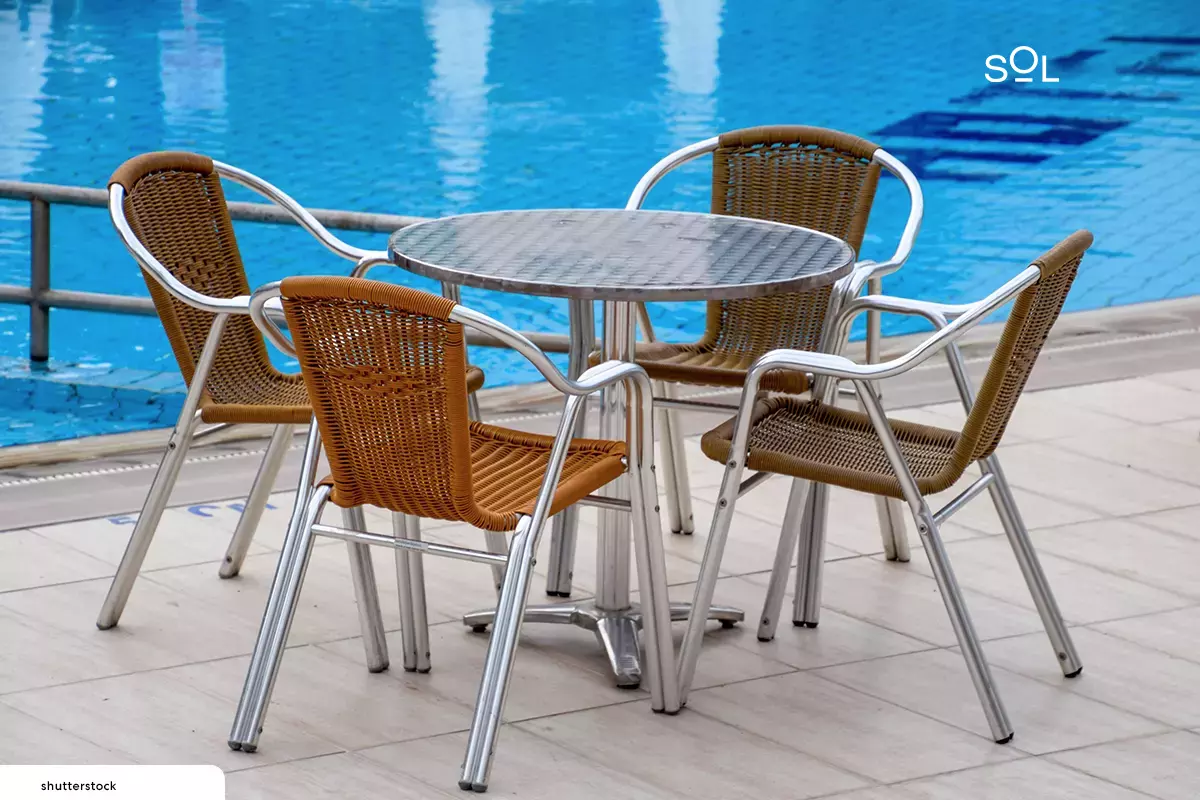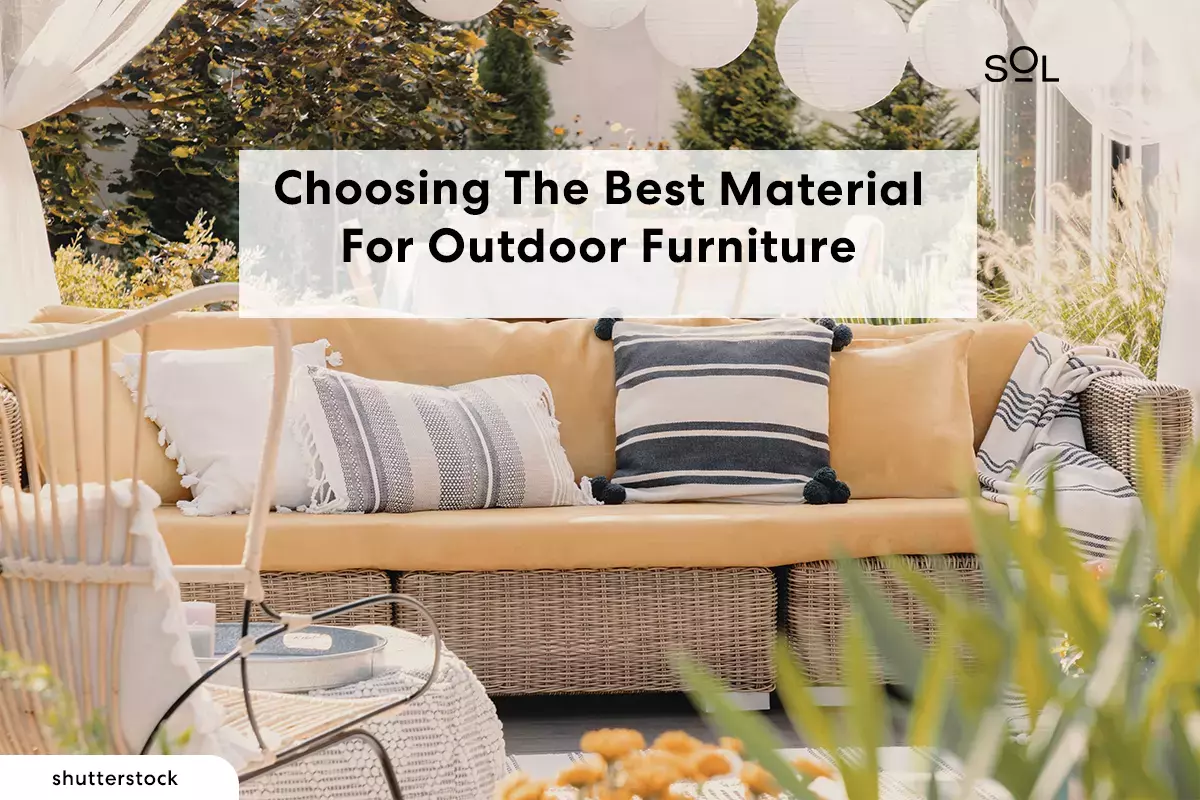A new setup for your patio is exciting as you finally get to decorate an outdoor space which will be a calming space to sit in during warmer months. But the worry of investing money in something that will be ruined because of rain or moisture outdoors is also understandable. Hence it is vital to select the best material for outdoor furniture.
Thankfully several outdoor furniture materials live up to the standard and can withstand outdoor weather conditions. This article will explain all you need about suitable material for patio furniture. Let’s find out!
Types of Materials for Outdoor Furniture
When considering the most durable outdoor furniture material, it is essential to consider that it must suit your area’s outdoor weather conditions. Since not all types of furniture materials are suitable for all climates, one needs to pay close attention to the qualities offered by each. Below are some top picks for outdoor furniture material.
Teak
A suitable garden furniture material that can withstand all weather conditions and look great? Well, teak is the answer. Thanks to the natural oils the wood produces, this material is perfect for 12 months of the year. Also, it is easy to maintain as you will need to scrub it with a brush and soap semi-annually. Although teak is expensive, its longevity and beautiful wood texture make it worth the price.

Acacia
If you live in a practically rainy region and still prefer wooden furniture for the patio, then acacia has suitable properties. It is water resistant and easily lasts a decade without worrying about placing it inside whenever it gets windy or rainy. Although it fades to a shiny silver over time, with an oil stain you can quickly regain the original golden shade. The cons? It needs regular cleaning and is expensive too.
Plastic
Plastic furniture is a good choice for outdoor furniture material, especially if you are fond of changing your furniture every few years. Plastic can imitate wicker, wood, and other materials while being lightweight, affordable, and accessible in various colors and textures. Also, furniture made from recycled plastic is solid and resistant to dampness, stains, mildew, and insects. Since they are also at a greater risk of being easily displaced by wind during storms, many plastic outdoor furniture need to be placed inside and cannot be left in the backyard throughout the year.
Aluminum
While we are on the subject of lightweight furniture options, aluminum is a top choice. An ideal option for outdoor seating, aluminum has the right level of lightness and strength. It is naturally resistant to corrosion and does not need to be covered or stored away. Though in the case of aluminum, protecting or covering it away will deteriorate the finish.

Iron
Are thunderstorms too common in your area? Well, opt for a patio furniture material that doesn’t move. Wrought iron is a good choice as a heavy and durable furniture option, and with several new changes, it is designed to look aesthetic too. Iron is a classic choice for modern backyard settings, from garden benches to dining sets and sofa frames with upholstery.
Wicker Rattan
Natural rattan fiber strips that are strong and resilient are closely woven to create wicker-style furniture. Furniture made of wicker or rattan is attractive, flexible, and comfy. When it rains or is exceptionally sunny, it is good to bring rattan furniture inside or cover it because it can fade in the sun and isn’t moisture-resistant. The rattan fibers may get looser over time.
Factors to Consider for Outdoor Materials
Proper research and knowledge are required to select the best material for outdoor furniture. You must understand how different materials compare in terms of cost, toughness, and aesthetics. Since there are several types of materials used to make outdoor furniture; each has advantages and disadvantages. Here are some factors to judge the correct type of outdoor furniture material for you.
Rain
Water-based issues are prevalent in furniture. Since we don’t have to worry about this fact when it comes to indoor furniture, outdoor furniture material has to be water and moisture-resistant. Water resistance is still a must-have quality for outdoor furniture, even if you plan to cover or store it inside each time it starts to pour.

Maintenance
You should consider the material’s maintenance requirements in addition to the overall design, particularly if you don’t have a place to keep your furniture during the winter to preserve it from the severe cold. Also, consider the weight, as heavier, more solid furniture can hold up better in severe winds than lighter items.
Mold Resistant
For outdoor furniture, humidity, and moisture is a constant companion for several months a year (Depending on your location too). And these conditions are ideal for the growth of mold and mildew. Now imagine your expensive couch looking all bad because of fungi. Not only does it look gross, but it smells too. The water and moisture retention and growth of fungi also cause several respiratory issues. Hence look for moisture-resistant outdoor furniture material.
Corrosion
This is the case with metals such as iron or steel, but a protective coating and a suitable alloy composition can prevent corrosion. And since many people opt for iron for outdoor furniture, it is essential to look for features such as rust-free coating. Or if you live in a salty air region, it is better to dump the idea of steel or iron furniture for your outdoor setting.
Light Fastness
The light fastness of a material is defined as its ability to retain its color and properties under prolonged exposure to the sun. And since the sun will be shining in your backyard, you need to ensure the material you choose does not lose its color or luster. This is especially required for the upholstery on the outdoor couches and chairs.
Heat Retention
Heat retention or conduction is a property through which a material absorbs heat within. Materials with high heat retention become uncomfortable or hazardous to touch after they have been exposed to sunlight for a long time. After all, nobody wants to sit on or move around in a lounge chair by the pool and burn their skin.
Environmentally Friendly
Furniture manufacturing involves lots of processes that are hazardous to the environment. Thankfully many furniture brands are now conscious of minimizing waste, reducing harmful impacts, and producing sustainable furniture. The project of SOL follows the same ideology of bringing eco-friendly furniture to every home.



